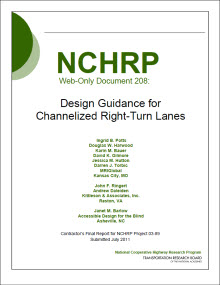 A new report from the National Cooperative Highway Research Program documents and presents the results of research to develop design guidance for channelized right-turn lanes.
A new report from the National Cooperative Highway Research Program documents and presents the results of research to develop design guidance for channelized right-turn lanes.
Observational field studies were conducted at 35 intersection approaches in cities to assess pedestrian crossing behavior, motorist yield behavior, and the interaction between pedestrians and motor vehicles at channelized right-turn lanes. Simulation modeling was performed to quantify the traffic operational benefits of channelized right-turn lanes with various types of traffic control and to compare the delay reduction of channelized right-turn lanes and conventional right-turn lanes. To compare the safety performance of the three right-turn treatment types, the report contains analysis of crash data for nearly 400 intersection approaches in Toronto, Ontario, Canada, including intersection approaches with channelized right-turn lanes, conventional right-turn lanes, and shared through/right-turn lanes.
The research results indicate that channelized right-turn lanes have a definite role in improving operations and safety at intersections, but to achieve these benefits, they should have consistent design and traffic control and should be used at appropriate locations. The research provides design guidance for channelized right-turn lanes that addresses geometric elements such as crosswalk location, special crosswalk signage and marking, island type, radius of turning roadway, angle of intersection with cross street, acceleration and deceleration lanes, and traffic control.